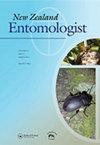Deployment of the sex pheromone of Pseudococcus calceolariae (Hemiptera: Pseudococcidae) as a potential new tool for mass trapping in citrus in South Australia
IF 0.4
4区 农林科学
Q4 ENTOMOLOGY
引用次数: 6
Abstract
ABSTRACT Mealybugs damage a variety of crops worldwide, vectoring viruses and causing problems from sooty mould. The identification of the citrophilous mealybug (Pseudococcus calceolariae, CMB) female sex pheromone has created opportunities for its use as a pest management tool that could potentially result in a reduced reliance on insecticides. Mass trapping is a pest management technique that uses baited traps to decrease pest insect densities. To assess the efficacy of the P. calceolariae sex pheromone as a mass trapping tool, a field trial was conducted in citrus in South Australia. The vertical distribution of CMB within the citrus was examined. Male flight activity was monitored using red delta traps in the centre of six 1-ha ‘plots’, after which time half the plots had 306 tent traps containing synthetic CMB pheromone lures deployed (mass traps). Six weeks after the application of mass trapping we observed a 90% lower catch in treated plots compared to catches in control plots. There were strong spatial patterns in trap catch with the Edge to Centre ratio being 3.6:1. P. calceolariae male flight activity showed peaks in October and May. Mass trapping showed promise as an effective management technique for P. calceolariae. Challenges such as male multiple mating and mealybug airborne dispersal still need to be overcome before mass trapping can be used as a reliable management technique.calceolariae假球菌(半翅目:假球菌科)性信息素在南澳大利亚柑橘中应用的研究
摘要:全球范围内,肉虫会破坏多种作物,传播病毒,并引发煤烟霉菌的问题。嗜柠檬粉蚧(Pseudococcus calceolariae,CMB)雌性性信息素的鉴定为其作为害虫管理工具的使用创造了机会,这可能会减少对杀虫剂的依赖。大规模诱捕是一种使用诱饵诱捕器来降低害虫密度的害虫管理技术。为了评估蒲团性信息素作为大规模诱捕工具的效果,在南澳大利亚的柑橘上进行了田间试验。研究了CMB在柑桔中的垂直分布。在六个1公顷“地块”的中心使用红色三角洲陷阱监测雄性飞行活动,之后,一半的地块部署了306个帐篷陷阱,其中包含合成CMB信息素诱饵(大规模陷阱)。在应用大规模诱捕六周后,我们观察到处理地块的渔获量比对照地块低90%。陷阱捕获物具有较强的空间格局,边缘与中心的比例为3.6:1。黄杨雄性飞行活动在10月和5月达到高峰,群体诱捕有望成为黄杨的有效管理技术。在大规模诱捕被用作可靠的管理技术之前,雄性多次交配和粉蚧空中传播等挑战仍需克服。
本文章由计算机程序翻译,如有差异,请以英文原文为准。
求助全文
约1分钟内获得全文
求助全文
来源期刊

New Zealand Entomologist
ENTOMOLOGY-
CiteScore
0.70
自引率
33.30%
发文量
3
审稿时长
>12 weeks
期刊介绍:
The invertebrate diversity of New Zealand is of great interest worldwide because of its geographic isolation and geological history. The New Zealand Entomologist plays an important role in disseminating information on field-based, experimental, and theoretical research.
The New Zealand Entomologist publishes original research papers, review papers and short communications. We welcome submissions in all aspects of science regarding insects and arthropods in a New Zealand or Australasian setting. The journal’s subject matter encompasses taxonomy, phylogenetics, biogeography, biological control and pest management, conservation, ecology and natural history.
The journal is the official publication of the Entomological Society of New Zealand. Papers published or submitted elsewhere for publication will not be considered, but publication of an abstract or summary elsewhere (e.g. conference proceedings) does not preclude full publication in the New Zealand Entomologist. Accepted papers become copyright of the Entomological Society of New Zealand. The journal is published in English, but we also welcome publication of abstracts in Maori.
 求助内容:
求助内容: 应助结果提醒方式:
应助结果提醒方式:


